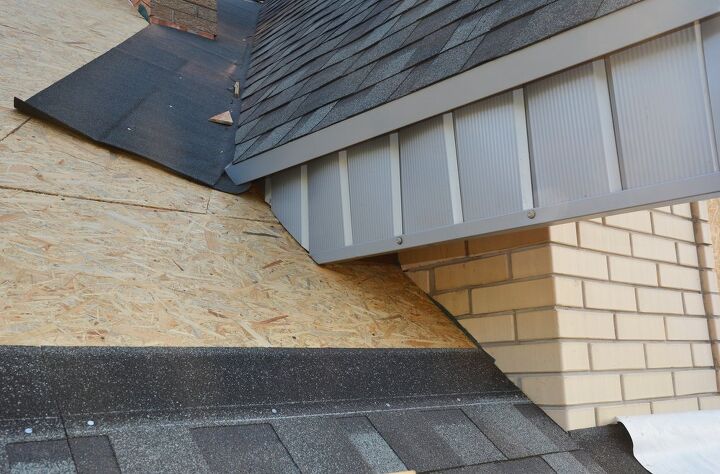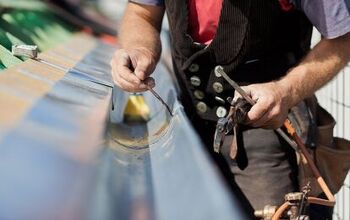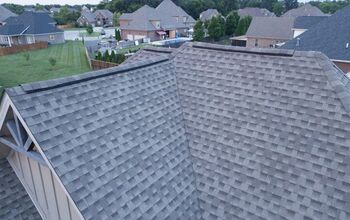What Is A Gutter Apron? (Find Out Now!)

It pours when it rains. When the rain stops, all of the rainfall ends up in your gutter system. We have a big problem on our hands if your gutter system captures little to no rainwater at all. A drip edge is frequently built on your roof to divert water towards the gutter. However, this isn’t always enough.
A gutter apron is a drip edge that has a 120-degree fold to funnel the water into your gutter so that it can flow the way that it’s supposed to. If your gutter system isn’t catching the rain then you’re going to have mold in your siding and rotting soffits. A gutter apron will help.
In this article, we will describe exactly what a gutter apron is, how it helps, and how it works. That way you know exactly what to expect if you ever need to add one to your home.
Do You Need Roofing, Siding, or Gutter Installers?
Get free, zero-commitment quotes from pro contractors near you.

What Is A Gutter Apron?
A gutter apron is a specially constructed drip edge that is folded at a 120-degree angle to help funnel water into your gutter. We’re all aware of the dangers of water seeping beneath your shingles, right?
A gutter system that does not gather rainfall can be just as damaging to your roof as one that does. This implies rotting soffits and mold in your siding. Even though drip edges were built to preserve your roof shingles, it’s still a good idea to pay attention to gutter flashing.
Because gutters are so important for keeping rainfall out of your roof, protecting them against mold, rot, and other long-term damage is critical.
How Does a Gutter Apron Work?
A gutter apron is built beneath your beginning shingle course and is especially useful if your roof shingles do not extend far enough into the gutter to funnel rainwater into the gutter.
Because gutter aprons are installed by hanging down an inch below the back of the gutter, gutter flashing also shields the back of the gutter. This shields your gutter from any dripping or splashing that occurs behind it.
In comparison to a drip edge gutter, where the gutter apron drapes over the roof sheathing, gutter aprons have wider dimensions.
They are a must-have roof material to add as part of your roof system if your shingles were not installed properly or channeling water to your gutter and behind it is an issue.
How To Install A Gutter Apron
Installing a gutter apron requires only two steps.
- Step 1: Slip the top section of your apron beneath the starting shingle course and secure it. The layer right above the roof sheathing is referred to as this.
- Step 2: Using roofing nails, lift the shingles and secure the gutter aprons.
Although installing a gutter apron is reasonably simple, we do not recommend doing so on your own. It takes deft handwork to lift the roofing shingles. Improper lifting may cause shingles to be damaged, requiring costly repairs.
You should also keep in mind that tile shingles, membrane roofing, and slate cannot be lifted, so ask your roofing contractor before starting the project. Finally, while installing a new roof, we recommend placing a gutter apron on the roof edge.
If you’re replacing your roof, you should consult a licensed roofing contractor to ensure that your roof system is safe.
How To Find A Reputable Roofing Company
The roofing firm that installs the material is just as important as the roofing material itself. With that in mind, here are a few things to think about:
Request A Quote
Requesting a quote will provide you with a range of alternatives from which to choose, allowing you to determine which roofing business is most suited to your requirements.
It’s all about whittling down your alternatives and taking into account your budget, labor quality, installation time, and warranty coverages.
Examine And Read Customer Reviews
When compared to speaking with a company directly, consumer ratings have a distinct edge. You’ll find unbiased evaluations that will give you useful information to help you make an informed decision. Of course, you’ll want to be sure the site where you’re reading the evaluations is reputable.
Consumer reviews can make or break a purchase, so keep that in mind. You’ll get a greater sense of how the company interacts with its consumers, the quality of their service, and the overall experience they had.
Overall, this is really useful in making a purchasing decision and will assist you in selecting the ideal roofing company.
Request For Proof Of Insurance
By requesting confirmation of insurance, you may avoid any additional costly repairs that may arise during the installation of the apron. This includes warranty coverage as well as a quality installation guarantee.
To protect your peace of mind during the installation, a good roofing business will provide proof of insurance, so seek for those who do and those who don’t.
Do You Need Roofing, Siding, or Gutter Installers?
Get free, zero-commitment quotes from pro contractors near you.

Is A Gutter Apron The Same as A Drip Edge?
While the primary function of both your gutter apron and drip edge is to funnel water into the gutter, they differ in size and installation.
A drip edge, for example, is normally in the shape of a T, but a gutter apron is in the shape of an L. Furthermore, gutter aprons are appropriate for roofs with a modest slope.
Advantage Of Having A Drip Edge
One of the most important benefits of having a drip edge is that it protects your fascia board. The health of your fascia board is jeopardized by water and excessive moisture.
Water is directed away from your fascia board and into the gutter by a drip edge, which is fitted along the eaves and roof edge.
Advantage Of Having A Gutter Apron
A gutter apron, on the other hand, has the advantage of requiring less maintenance over time. The fundamental function of gutter flashing or gutter aprons is to catch all of the water. This saves you the trouble and stress of having to gather and clean the water from the attic on your own.
Related Guide

Heather is a passionate writer who loves anything DIY. Growing up, she learned everything from home repairs to design, and wants to share her tips with you. When she's not writing, she's usually hiking or searching for her next DIY project.
More by Heather Robbins



























